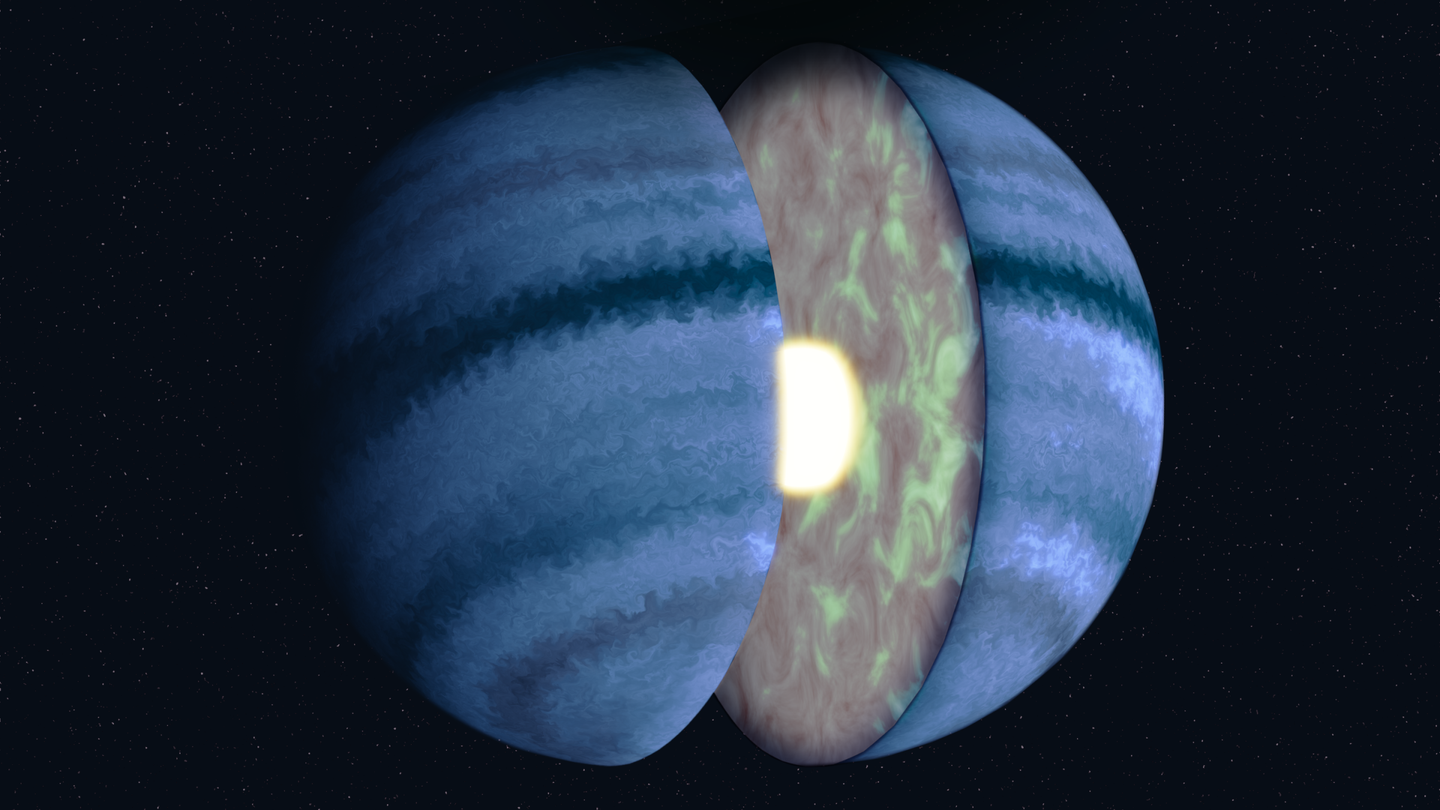Astronomers discover strange exoplanet with one of the lowest densities ever recorded
Discover how James Webb Space Telescope revealed surprising atmospheric asymmetry on WASP-107 b, challenging existing exoplanetary models.

Artist’s concept of WASP-107 b, a warm Neptune exoplanet about 200 light-years away. (CREDIT: Roberto Molar Candanosa / Johns Hopkins University)
Astronomers are uncovering new insights into exoplanetary atmospheres, and a recent study on WASP-107 b has turned conventional models on their heads. This distant planet, with its incredibly low density and unique atmospheric features, has become a focal point for researchers delving into the complexities of planetary systems outside our solar neighborhood.
Discovered in 2017, WASP-107 b is an exoplanet that defies expectations. It boasts a mass similar to Neptune but a radius comparable to Jupiter, giving it one of the lowest bulk densities ever recorded.
At just 0.126 g/cm³, this density is about one-fifth that of Saturn, the least dense planet in our solar system. Such a composition suggests WASP-107 b has an extensive atmosphere made predominantly of hydrogen and helium, contributing to its unusually inflated appearance.
Researchers from the University of Arizona, alongside an international team, recently used NASA’s James Webb Space Telescope (JWST) to analyze the planet’s atmosphere. Their findings, published in Nature Astronomy, revealed a surprising east-west asymmetry in atmospheric properties.
"This is the first time the east-west asymmetry of any exoplanet has ever been observed as it transits its star, from space," said lead author Matthew Murphy, a graduate student at the University of Arizona’s Steward Observatory. These observations challenge existing models, which predicted uniform atmospheric characteristics for planets with equilibrium temperatures as low as WASP-107 b’s 770 K (about 890°F).
The phenomenon of east-west asymmetry arises from differences in temperature and cloud properties between the eastern and western edges of a planet’s atmosphere. For tidally locked exoplanets like WASP-107 b, which always show the same face to their star, one hemisphere experiences perpetual daylight while the other remains in constant darkness. This stark division often creates significant contrasts in atmospheric dynamics.
Using transmission spectroscopy, the team identified a 100 K temperature difference between the planet’s morning and evening limbs, with the evening side being hotter. This technique involves capturing starlight as it passes through the planet’s atmosphere during a transit, providing detailed information about atmospheric composition and structure.
"These snapshots tell us a lot about the gases in the exoplanet’s atmosphere, the clouds, structure of the atmosphere, the chemistry, and how everything changes when receiving different amounts of sunlight," Murphy explained.
Related Stories
The JWST’s advanced capabilities allowed researchers to separate atmospheric signals from each limb, offering unprecedented insights into the planet’s localized atmospheric processes. Such precision was previously unattainable with ground-based telescopes.
"For almost all exoplanets, we can't even look at them directly, let alone be able to know what's going on one side versus the other," Murphy said. "For the first time, we're able to take a much more localized view of what's going on in an exoplanet's atmosphere."
The unexpected asymmetry in WASP-107 b’s atmosphere challenges traditional models of atmospheric dynamics. Earlier theories suggested that such asymmetries should diminish at temperatures below 1,200 K, as cooler atmospheres are less prone to dramatic variations. WASP-107 b’s equilibrium temperature places it well within this regime, yet its atmosphere displays significant spatial heterogeneity.
Models typically predict that global atmospheric circulation on tidally locked planets advects heat from the dayside to the nightside, creating variations in temperature and cloud properties along the planet’s limbs. The team’s observations, however, suggest a more complex reality.
The evening limb’s higher temperature likely results in fewer condensed cloud particles, while the cooler morning limb may harbor denser cloud formations. This variability impacts the transmission of starlight through each limb, which must be accounted for to avoid biases in atmospheric data retrieved from observations.
"Traditionally, our observing techniques don't work as well for these intermediate planets, so there's been a lot of exciting open questions that we can finally start to answer," Murphy noted. "Some of our models told us that a planet like WASP-107 b shouldn't have this asymmetry at all – so we're already learning something new."
WASP-107 b’s highly inflated atmosphere and low gravity make it a prime candidate for studying atmospheric dynamics in detail. While ultra-hot exoplanets with temperatures exceeding 2,000 K have shown clear asymmetries in previous studies, this is the first evidence of such phenomena in a cooler exoplanet.
"This is really the first time that we've seen these types of asymmetries directly in the form of transmission spectroscopy from space, which is the primary way in which we understand what exoplanet atmospheres are made of – it's actually amazing," said Thomas Beatty, a co-author of the study and assistant professor of astronomy at the University of Wisconsin-Madison.
The findings pave the way for further investigations into intermediate-temperature exoplanets, potentially revealing new aspects of atmospheric chemistry and climate.
Future studies will build on these observations, aiming to explore whether WASP-107 b’s asymmetry is an anomaly or part of a broader trend among cooler exoplanets. The team plans to conduct additional observations using the JWST to better understand the mechanisms driving these differences.
"For almost two decades, we've been trying to infer what exoplanet atmospheres might look like from indirect observations," Murphy said. "Now, we're finally able to test those models with direct, high-precision data."
WASP-107 b represents a turning point in exoplanet research. By challenging existing models and revealing the complexities of atmospheric dynamics in cooler planets, this study highlights the importance of high-resolution space-based observations. The unprecedented detail provided by the JWST offers a glimpse into the diverse climates and environments that exist beyond our solar system.
As researchers continue to refine their understanding of exoplanetary atmospheres, each discovery brings us closer to answering fundamental questions about planetary formation, climate dynamics, and the potential for habitability in distant worlds.
Note: Materials provided above by The Brighter Side of News. Content may be edited for style and length.
Like these kind of feel good stories? Get The Brighter Side of News' newsletter.
Joshua Shavit
Science & Technology Writer | AI and Robotics Reporter
Joshua Shavit is a Los Angeles-based science and technology writer with a passion for exploring the breakthroughs shaping the future. As a contributor to The Brighter Side of News, he focuses on positive and transformative advancements in AI, technology, physics, engineering, robotics and space science. Joshua is currently working towards a Bachelor of Science in Business Administration at the University of California, Berkeley. He combines his academic background with a talent for storytelling, making complex scientific discoveries engaging and accessible. His work highlights the innovators behind the ideas, bringing readers closer to the people driving progress.



